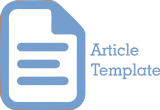The Relationship Between Mothers' Knowledge Level About Exclusive Breastfeeding and the Incidence of Stunting in Children Aged 24-59 Months
Abstract
Children under five years-old (toddlers) were very vulnerable to nutritional deficits and one of the most common was stunting. Indonesia has the third highest prevalence in Southeast Asia. Stunting incidence often occurs in toddlers aged 24-59 months with one of the risk factors, namely unbalanced food intake, including not giving exclusive breastfeeding. Lack of maternal knowledge can cause poor parenting, especially exclusive breastfeeding. The aim of the study was to discovered the relationship between maternal knowledge and exclusive breastfeeding with the incidence of stunting in toddlers aged 24-59 months in work area of Kersana Public Health Center, Brebes Regency. This study used an observational analytic approach with sectional cross design. The number of research samples used in this study was 85 selective people with a technique of concecutive sampling. Data was taken using questionnaire and the analytical technique used Spearman correlation test. Most of respondents were aged 31-40 years (53,7%), elementary school education level (47,1%), maternal status (82,4%), and who had daughters (56,5%). The results of the Spearman correlation test showed that there was a significant relationship between the maternal knowledge (p = 0.000, r = -0.886), and exclusive breastfeeding (p = 0.000, r = -0.661) with the incidence of stuntin. The study concluded that there was a significant relationship between maternal knowledge and exclusive breastfeeding with the incidence of stunting in toddlers aged 24-59 months in work area of Kersana Public Health Center, Brebes Regency, with a negative correlation direction.
References
Amir, A., Nursalim, N., & Widyansyah, A. (2018). Faktor-faktor yang mempengaruhi pemberian ASI pada bayi neonatal di RSIA Pertiwi Makassar. Media Gizi Pangan, 25(1), 47–54. https://doi.org/10.32382/mgp.v25i1.59
Balogun, O. O., Dagvadorj, A., Anigo, K. M., Ota, E., & Sasaki, S. (2015). Factors influencing breastfeeding exclusivity during the first 6 months of life in developing countries: a quantitative and qualitative systematic review. Maternal & child nutrition, 11(4), 433-451. https://doi.org/10.1111/mcn.12180
Dewi, A. P., Ariski, T. N., & Kumalasari, D. (2019). Faktor–Faktor yang berhubungan dengan kejadian stunting pada balita 24–36 bulan di Wilayah Kerja UPT Puskesmas Gadingrejo Kabupaten Pringsewu. Wellness And Healthy Magazine, 1(2), 231–237.
Gewa, C. A., & Chepkemboi, J. (2016). Maternal knowledge, outcome expectancies and normative beliefs as determinants of cessation of exclusive breastfeeding: a cross-sectional study in rural Kenya. BMC Public Health, 16, 1–9. https://doi.org/10.1186/s12889-016-2907-2
Hanson, L. Å., & Korotkova, M. (2002, August). The role of breastfeeding in prevention of neonatal infection. In Seminars in neonatology (Vol. 7, No. 4, pp. 275-281). WB Saunders. https://doi.org/10.1053/siny.2002.0124
Hikmahrachim, H. G., Rohsiswatmo, R., & Ronoatmodjo, S. (2020). Efek ASI Eksklusif terhadap Stunting pada Anak Usia 6-59 bulan di Kabupaten Bogor tahun 2019. Jurnal Epidemiologi Kesehatan Indonesia, 3(2). https://doi.org/10.7454/epidkes.v3i2.3425
Kemenkes, R. I. (2018). Situasi balita pendek (Stunting) di Indonesia. Kementerian Kesehatan RI, 301(5), 1163–1178.
Komalasari, K., Supriati, E., Sanjaya, R., & Ifayanti, H. (2020). Faktor-faktor penyebab kejadian stunting pada balita. Majalah Kesehatan Indonesia, 1(2), 51–56. https://doi.org/10.47679/makein.202010
Langi, G. K. L., Djendra, I. M., Purba, R. B., & Todanggene, R. S. P. (2019). Pengetahuan Ibu Dan Pemberian Asi Eksklusif Dengan Kejadian Stunting Pada Balita 2-5 Tahun Di Puskesmas Kawangkoan Minahasa. Jurnal GIZIDO, 11(01), 17–22. https://doi.org/10.47718/gizi.v11i01.750
Lelo, N. S., Mau, D. T., & Rua, Y. M. (2021). Gambaran Tingkat Pengetahuan Ibu Tentang Pemberian ASI Eksklusif Di UPTD Puskesmas Haliwen. Jurnal Sahabat Keperawatan, 3(01), 18–22. https://doi.org/10.32938/jsk.v3i01.913
Margawati, A., & Astuti, A. M. (2018). Pengetahuan ibu, pola makan dan status gizi pada anak stunting usia 1-5 tahun di Kelurahan Bangetayu, Kecamatan Genuk, Semarang. Jurnal Gizi Indonesia (The Indonesian Journal of Nutrition), 6(2), 82–89. : https://doi.org/10.14710/jgi.6.2.82-89
Mentari, S., & Hermansyah, A. (2019). Faktor-faktor yang berhubungan dengan status stunting anak usia 24-59 bulan di wilayah kerja UPK puskesmas Siantan Hulu. Pontianak Nutrition Journal (PNJ), 1(1), 1–5. https://doi.org/10.30602/pnj.v1i1.275
Nasrabadi, M., Vahedian-Shahroodi, M., Esmaily, H., Tehrani, H., & Gholian-Aval, M. (2019). Factors affecting Exclusive breastfeeding in the first six months of birth: An Exploratory-Descriptive Study. Journal of Midwifery & Reproductive Health, 7(3). https://doi.org/10.22038/jmrh.2018.27330.1297
Normalasari, E., & Mardiana, M. (2017). Evaluasi Program Konseling Menyusui di Puskesmas Klikiran Kabupaten Brebes. HIGEIA (Journal of Public Health Research and Development), 1(1), 52–58.
Novianti, E., Ramdhanie, G. G., & Purnama, D. (2021). Faktor-Faktor Yang Mempengaruhi Pemberian Makanan Pendamping ASI (MP ASI) Dini–Studi Literatur. Jurnal Kesehatan Bakti Tunas Husada: Jurnal Ilmu-ilmu Keperawatan, Analis Kesehatan dan Farmasi, 21(2), 344-367. http://dx.doi.org/10.36465/jkbth.v21i2.765
Nugraheni, D., Nuryanto, N., Wijayanti, H. S., Panunggal, B., & Syauqy, A. (2020). Asi Eksklusif Dan Asupan Energi Berhubungan Dengan Kejadian Stunting Pada Usia 6–24 Bulan Di Jawa Tengah. Journal of Nutrition College, 9(2), 106–113. https://doi.org/10.14710/jnc.v9i2.27126
Pangkong, M., Rattu, A. J. M., & Malonda, N. S. H. (2017). Hubungan antara pemberian ASI eksklusif dengan kejadian stunting pada anak usia 13-36 bulan di wilayah kerja Puskesmas Sonder. Kesmas, 6(3).
Rahmawati, L. A., Hardy, F. R., & Anggraeni, A. (2020). Faktor-faktor yang berhubungan dengan stunting sangat pendek dan pendek pada anak usia 24-59 bulan di Kecamatan Sawah Besar. Jurnal Ilmiah Kesehatan Masyarakat: Media Komunikasi Komunitas Kesehatan Masyarakat, 12(2), 68–78. https://doi.org/10.52022/jikm.v12i2.36
Ratnasari, D., & Endriani, R. (2020). Hubungan Status Berat Badan Lahir Rendah (BBLR) dengan Kejadian Stunting. Syntax Idea, 2(1), 11–20. https://doi.org/10.46799/syntax-idea.v2i1.118
Rayhana, R., & Amalia, C. N. (2021). Pengaruh pemberian ASI, imunisasi, MP-ASI, penyakit ibu dan anak terhadap kejadian stunting pada balita. Muhammadiyah Journal of Nutrition and Food Science (MJNF), 1(2), 60–69. https://doi.org/10.24853/mjnf.1.2.60-69
SJMJ, S. A. S., Toban, R. C., & Madi, M. A. (2020). Hubungan pemberian ASI eksklusif dengan kejadian stunting pada balita. Jurnal Ilmiah Kesehatan Sandi Husada, 9(1), 448–455. https://doi.org/10.35816/jiskh.v11i1.314
Umiyah, A., & Hamidiyah, A. (2020). Exclusive Breastfeeding With Stunting. STRADA Jurnal Ilmiah Kesehatan, 9(2), 471-477. https://doi.org/10.30994/sjik.v9i2.454
Wendiranti, C. I., Subagio, H. W., & Wijayanti, H. S. (2017). Faktor Risiko Kegagalan ASI Eksklusif. Diponegoro University.
Yoga, I. T. (2020). Rokhaidah.(2020). Pengetahuan Ibu Tentang Stunting Pada Balita Di Posyandu Desa Segarajaya. Indonesian Journal of Health Development, 2(3), 183–192.
Copyright (c) 2024 Journal La Medihealtico

This work is licensed under a Creative Commons Attribution-ShareAlike 4.0 International License.








